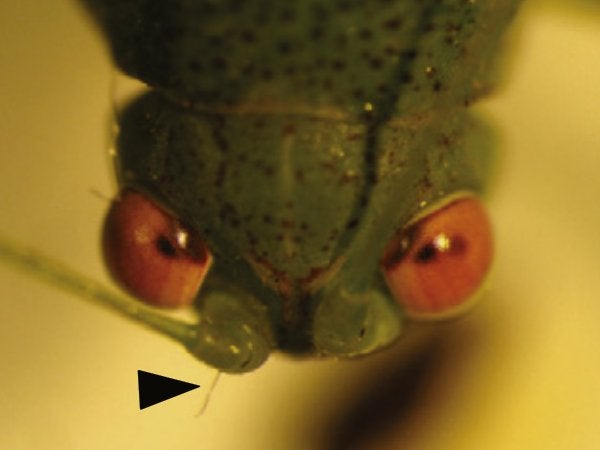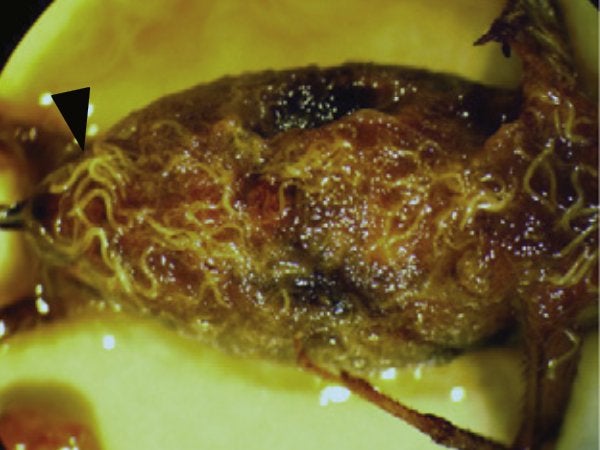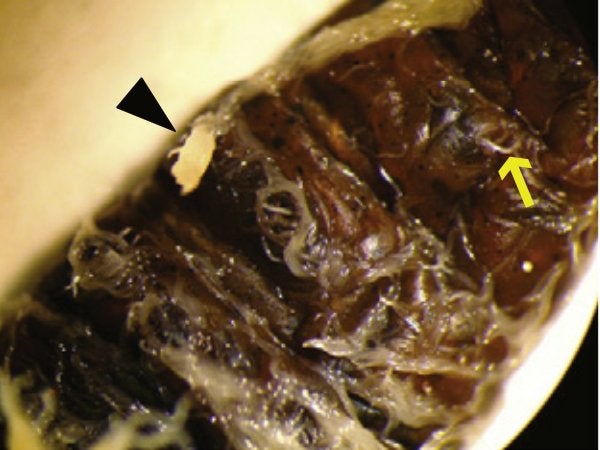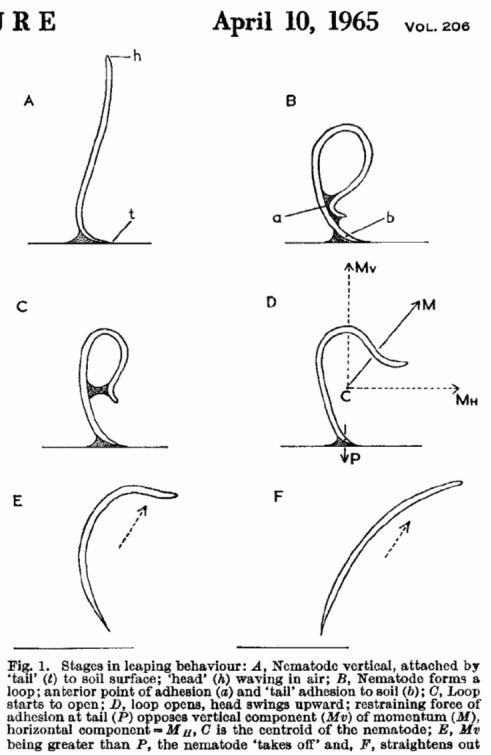This article was published in Scientific American’s former blog network and reflects the views of the author, not necessarily those of Scientific American
Author’s note: My blog's survey ends tomorrow (the 20th), and all readers -- even new ones -- are invited to take it! Please see the end of this post for details.
We humans are not the best leapers, but like most things, that doesn’t stop us from trying. The world record men’s long jump is 24 feet, four and a quarter inches, or about four times the height of a six-foot man. The record high jump is 8 feet and one-half inch -- barely more than one human height.
Yet a tiny nematode worm called Steinernema can fling itself nearly ten times its own length and seven times its height in pursuit of a new host insect. It would be as if while walking through the forest, you had to dodge flesh-eating earthworms tossing themselves at you from the ground (and you had no handy fingers and opposable thumbs with which to remove them. Love those thumbs!!).
On supporting science journalism
If you're enjoying this article, consider supporting our award-winning journalism by subscribing. By purchasing a subscription you are helping to ensure the future of impactful stories about the discoveries and ideas shaping our world today.
Yet if you are a cricket or a katydid, this is your reality.

Things are not looking good for this katydid, who has acquired a deadly hitchhiker indicated by the arrow. Fig. 1E from Hallem et al. 2011. Click here for source.
Nematodes are tiny animals that are also called roundworms. Though relatively simple in design, the basic nematode body plan has gone through enormous natural selection to produce some pretty wild variations (as I blogged about in "A Stuffy Government Yearbook and Its Beautiful, Exotic Worms"). They also dominate the Earth numerically (as I wrote in “Nematode Roundworms Own This Place”) – four out of every five animals on Earth is a nematode. They are found sucking on plants, attacking or scavenging prey in nearly every environment on the planet.
Nematodes that jump – of which all known are in the genus Steinernema -- are either parasitic or in a stage that actively hitches rides on passing insects. Steinernema specializes in turning their host into a live-in/eat-in kitchen; once finished with it, crawling outside said home’s putrefying remains; identifying a new chump and crawling onto or, if necessary, launching themselves onto it; boring inside; releasing a horde of lethal symbiotic bacteria that quickly overwhelm and kill the insect; and then proceeding to eat and make little worms inside the cadaver for two to three generations so a new nematode can crawl outside and do it all over again. Fun fun!

Adult Steinernema helping themselves to an all-you-can-eat cricket cadaver buffet. Arrowhead indicates an individual worm. Fig. 1F from Hallem et al. 2011. Click here for source.

Steinernema nematodes gorging themselves on delicious dead waxworm. Arrowhead shows a group of them emerging from the body in a clump, part of nictation behavior aimed at getting picked up by the next waxworm. Yellow arrow indicates an individual worm. Fig. 1G from Hallem et al. 2011. Click here for source.
Nematodes don’t just jump blindly, either. Identifying their next host is done in response to environmental cues, specifically, when a nematode smells its next meal delivering itself. And not only can the nematodes smell their next meal coming and jump to snag it, they can aim based on the movement of air around them.
The reason we know so much about these particular nematodes is that we use them as biocontrol agents for insect pests. Steinernema is not picky. It attacks a wide range of insects.
Scientists realized as early as 1965 that some nematodes possessed astounding acrobatic ability. The first report, in no less venerable a publication than Nature [Disclaimer: Scientific American is owned by Nature], described an enigmatic nematode referred to only by its Super Spy Code Name “DD 136” that possessed this particular bit of roundworm magic.
In a series of elegant schematics, the scientists laid out the launch sequence necessary to send a roundworm into low-Earth orbit (or at least onto the nearest cricket):

Fig. 1 from Reed and Wallace 1965. Click here for source.
As this first team interpreted events, a nematode first plants itself like a flagpole, standing erect on a bent tail. Standing is best because it reduces the surface tension experienced by the worm, making it easier either to latch on to a passing animal or to jump if necessary.
In this position, the worm first waves back and forth, a behavior called nictation. If this action fails to secure new lodgings, the nematode then folds back on itself so that its head touches its body near the tail, forming a loop sealed by a moisture droplet. The muscles on the inside of the loop contract to hold the pose, which is opposed in part by hydrostatic pressure, the pressure of bodily fluids on the animal’s cuticle, or skin (this kind of pressure is the same that you would feel by folding a balloon artist’s balloon in half).
When the worm is ready to rock and roll, it relaxes the muscles on the inside of the loop and contracts the muscles on the outside. This force, together with hydrostatic pressure, places tension on the loop that’s opposed by the surface tension of the water droplet pulling the other way. Eventually, the nematode defeats the droplet, which catastrophically fails. The potential energy of the bend is suddenly converted into kinetic energy and the worm snaps back into shape. The acceleration of the nematode’s head as it resumes its natural position produces momentum that frees the nematode from the droplet holding its tail to the surface and sends it off into the wild blue yonder.
In 1999, another group, also writing in Nature, characterized this earlier explanation as “inaccurate”. According to them, once the nematode forms the loop of its body, it then uses its normal S-shaped crawling movement to slide its head toward its tail on the ground, making the loop smaller but the bend in it tighter. When the cuticle on the top of the loop becomes sufficiently stretched and the cuticle on the inside of the loop kinks under the pressure, sufficient force is amassed to break the surface tension in the water droplet holding the loop together. The rest of the leap happens pretty much as described before.
To watch this happening in real life, check out the videos of nematode jumping taken by a team of scientists at Cal Tech available here and here. You can practically hear the “Pee-yew!!!” sound effect.
The force of the loop snapping open is enough not only to break the tension holding the worm to its surface droplet, but also to propel it an average of nine times its body length across the ground (5 millimeters, or half a centimeter) and seven times its body length high (4 millimeters), the authors calculated.
Although the Nematode Space Program is admittedly in its infancy, members of Steinernema have vowed to put a nematode on the moon by the end of this decade. Though that may sound ambitious, they have already managed to travel deeper than any human has made it unassisted, at least 1.3 kilometers (and possibly 3.6km) beneath Earth’s surface. So really ... anything is possible.
___________
Last chance for the blog survey – ends tomorrow (Nov. 20)! I’ve teamed up with researcher Paige Brown Jarreau -- author of the blog From the Lab Bench -- to create a survey of all of my readers – new, old, and first-time readers alike. By participating, you’ll be helping me improve The Artful Amoeba and contribute to SCIENCE on blog readership. You will also get FREE science art from Paige's Photography for participating, as well as a chance to win a $50.00 Amazon gift card (100 available, or guaranteed 2 per specific blog included in this survey) or a T-shirt. It should only take 10-15 minutes to complete. You can find the survey here: http://bit.ly/mysciblogreaders.
References
Campbell, James F., and Harry K. Kaya. "How and why a parasitic nematode jumps." Nature 397, no. 6719 (1999): 485-486.
Hallem, Elissa A., Adler R. Dillman, Annie V. Hong, Yuanjun Zhang, Jessica M. Yano, Stephanie F. DeMarco, and Paul W. Sternberg. "A sensory code for host seeking in parasitic nematodes." Current Biology 21, no. 5 (2011): 377-383.
Reed, E. M., and H. R. Wallace. "Leaping locomotion by an insect-parasitic nematode." Nature 206 (1965): 210-211.